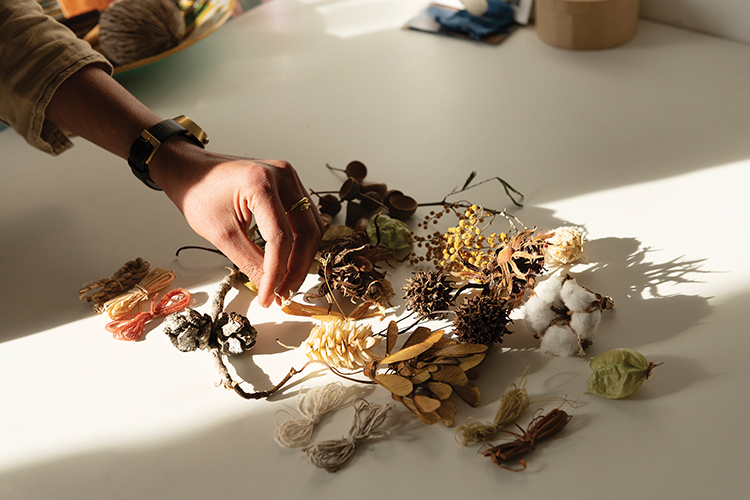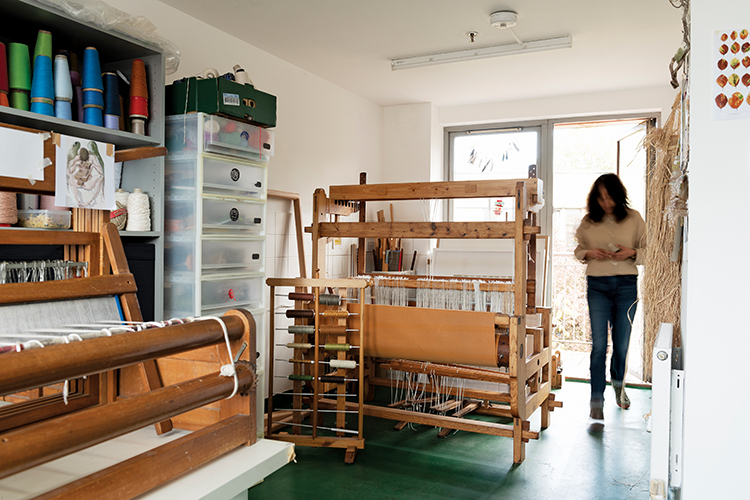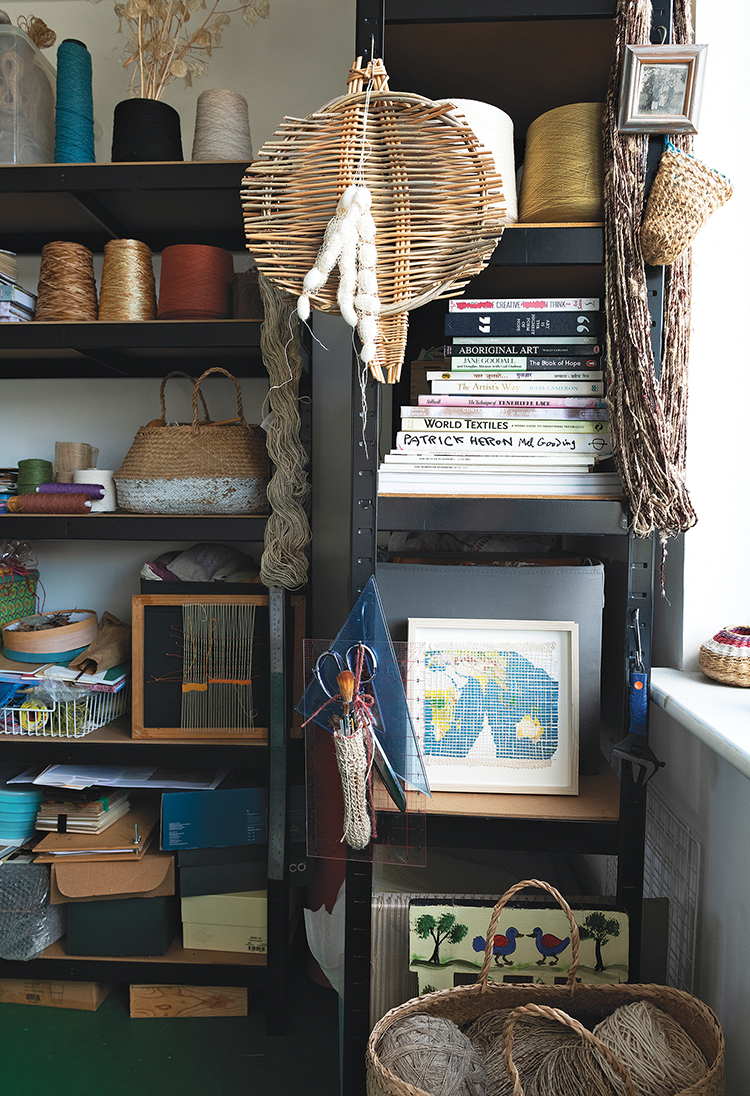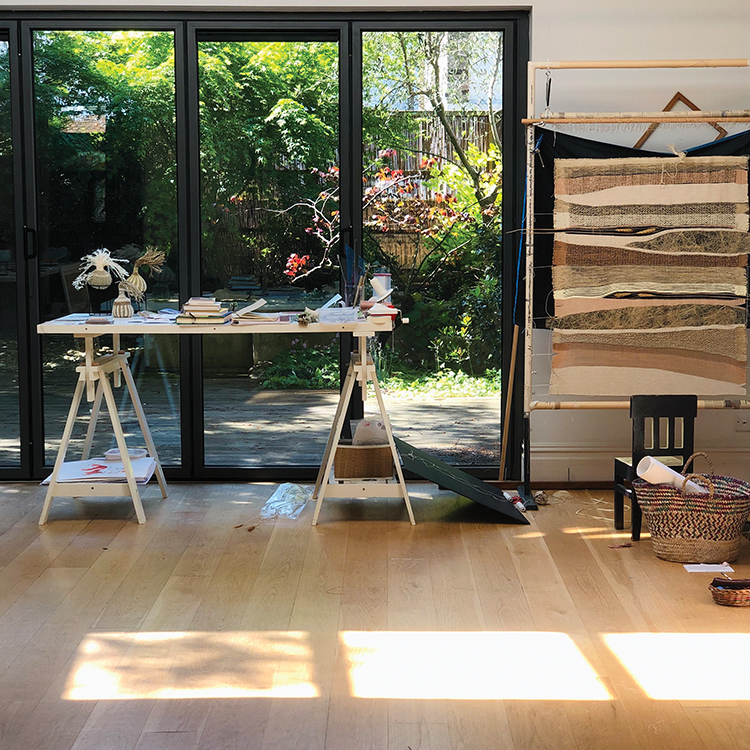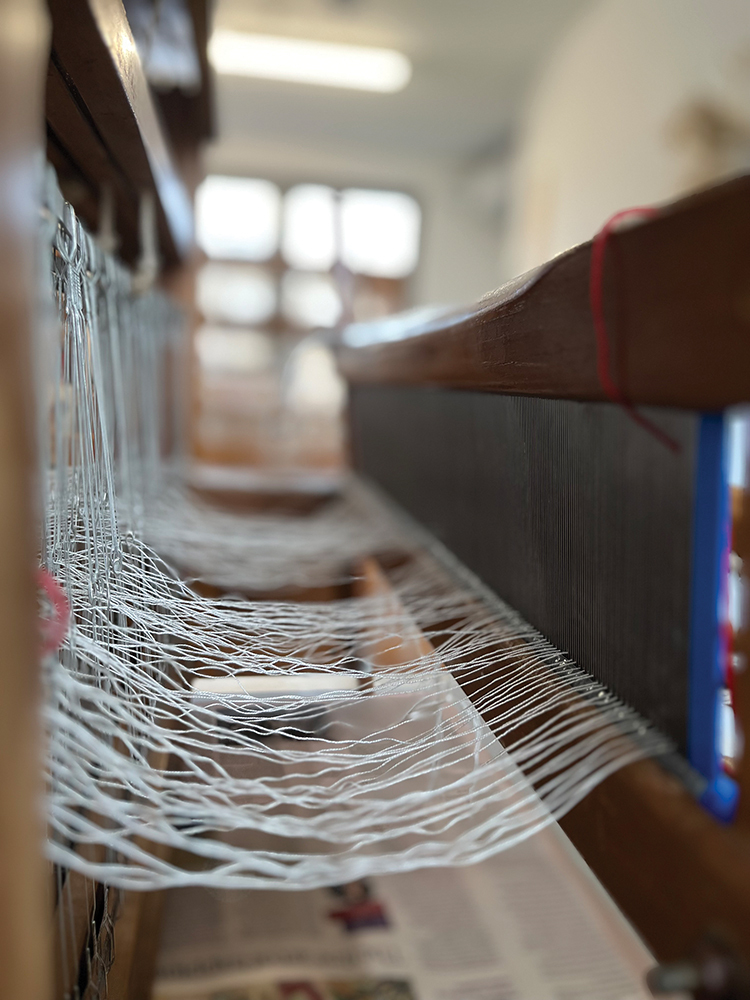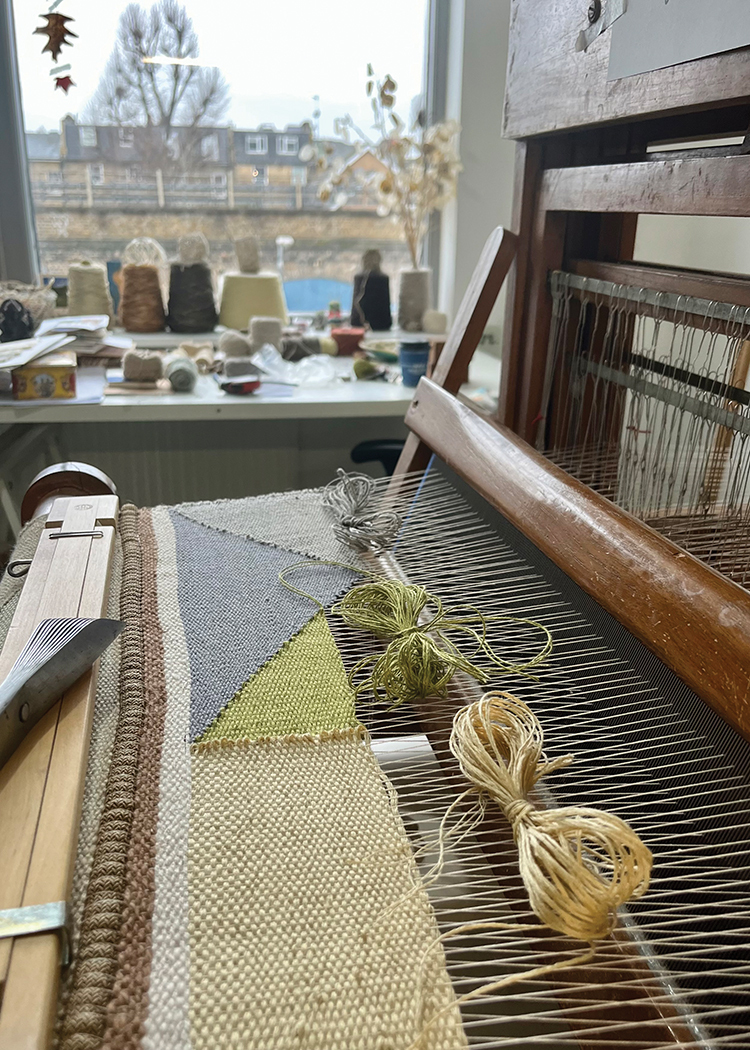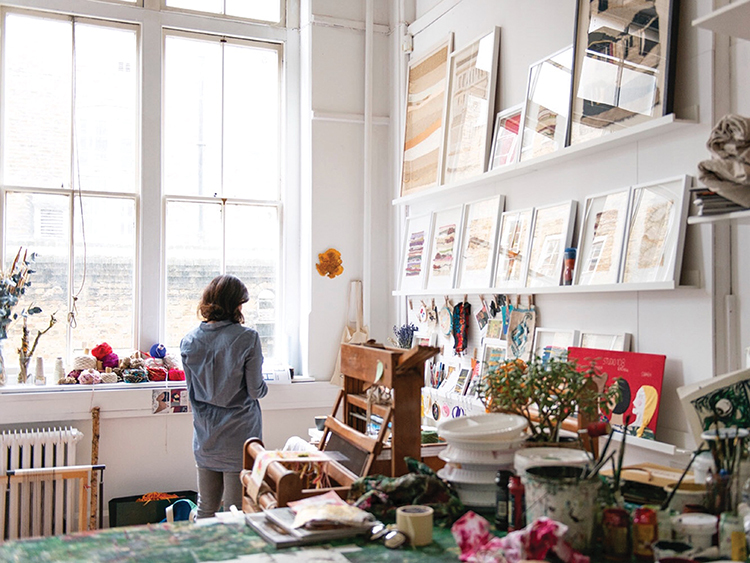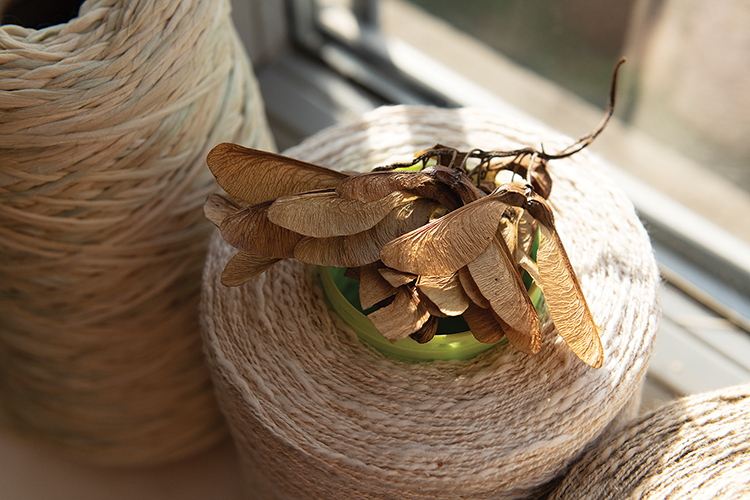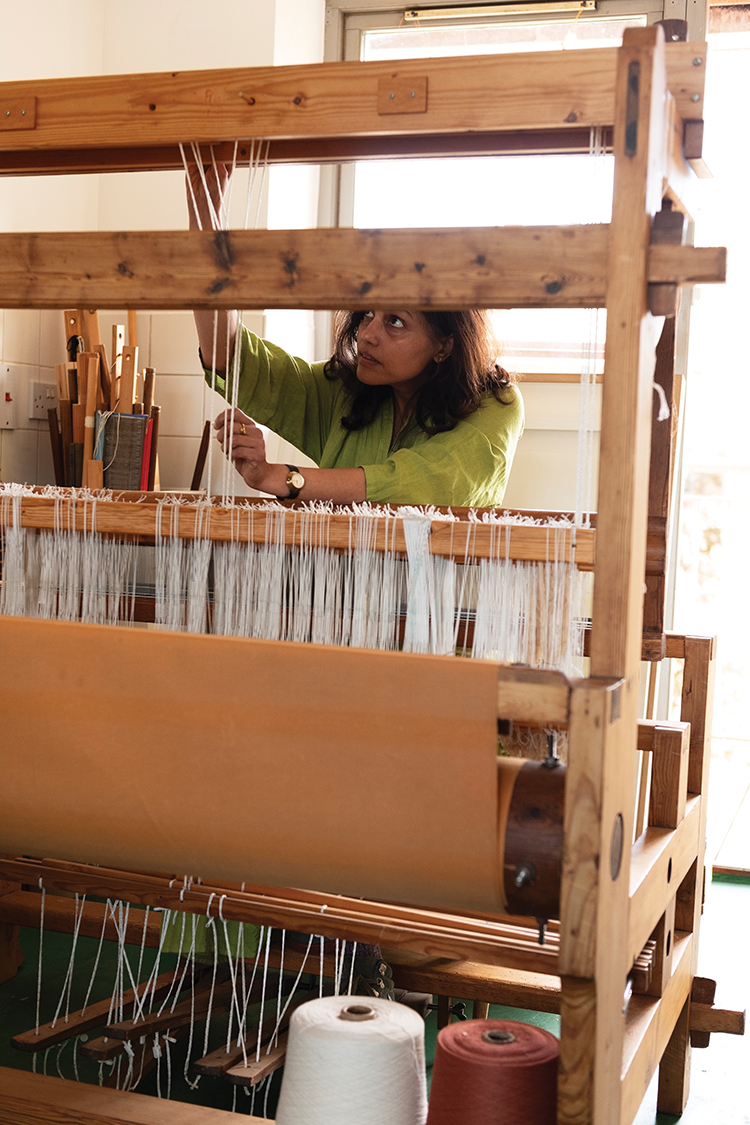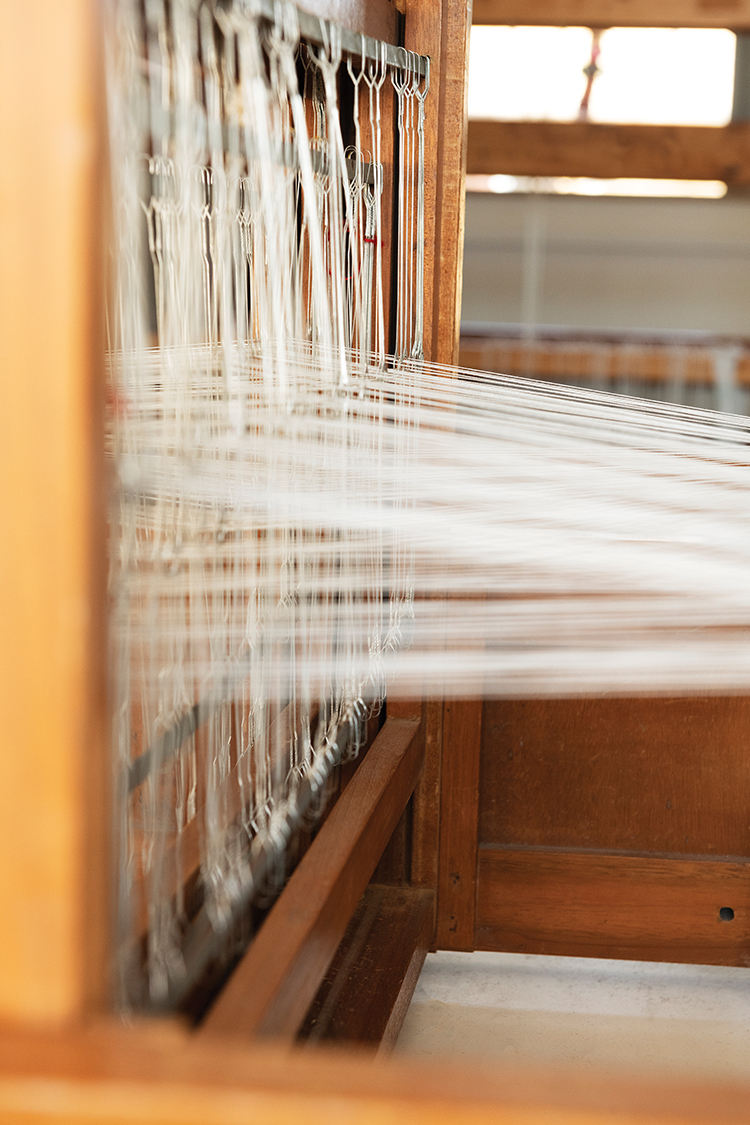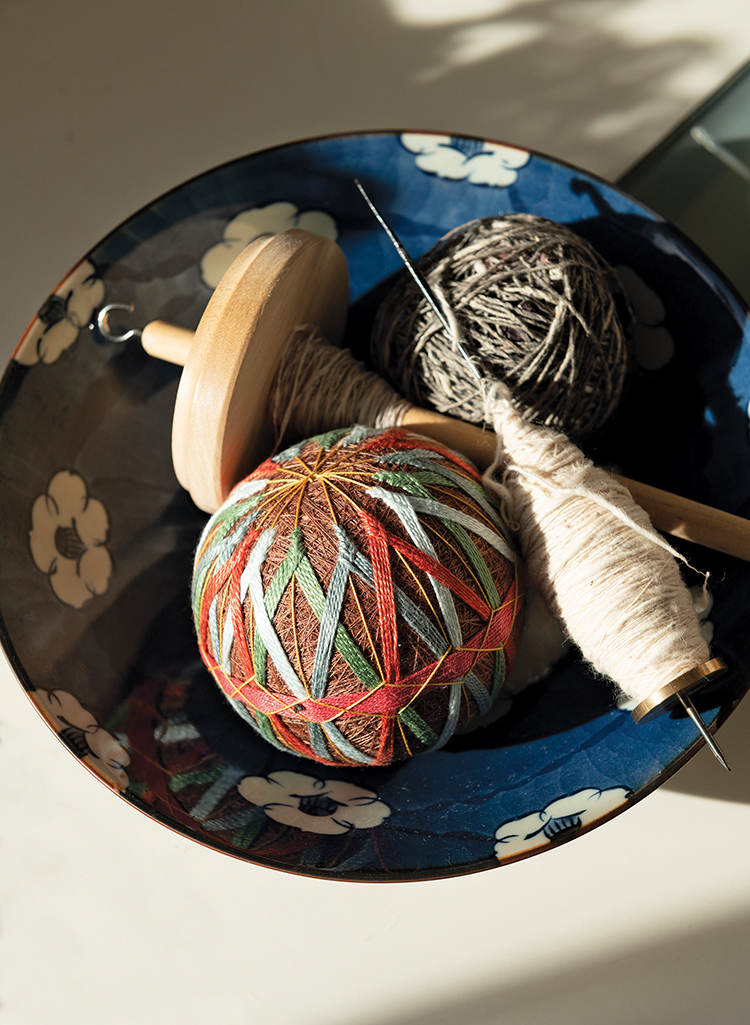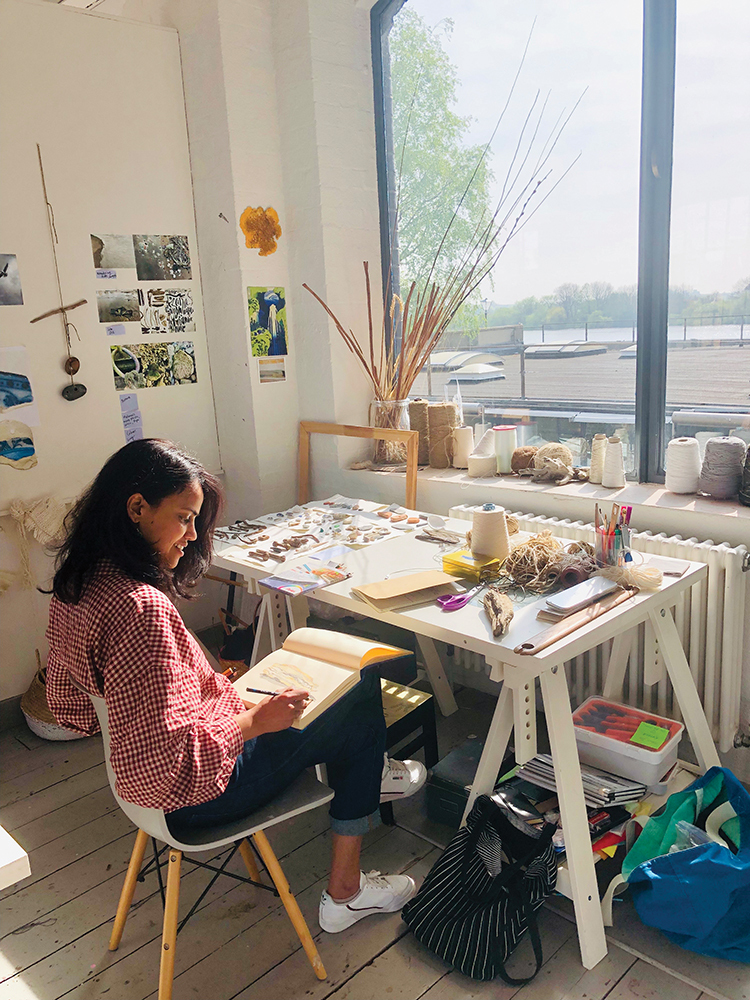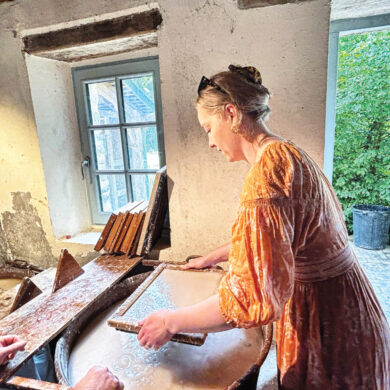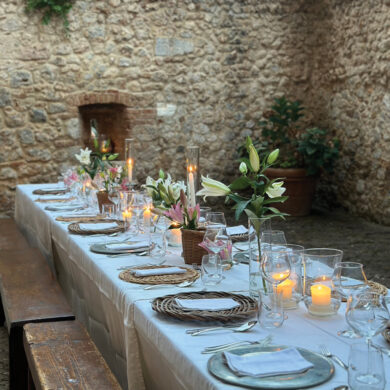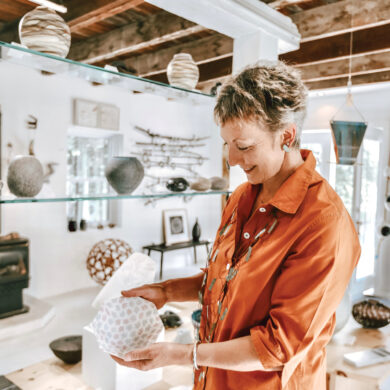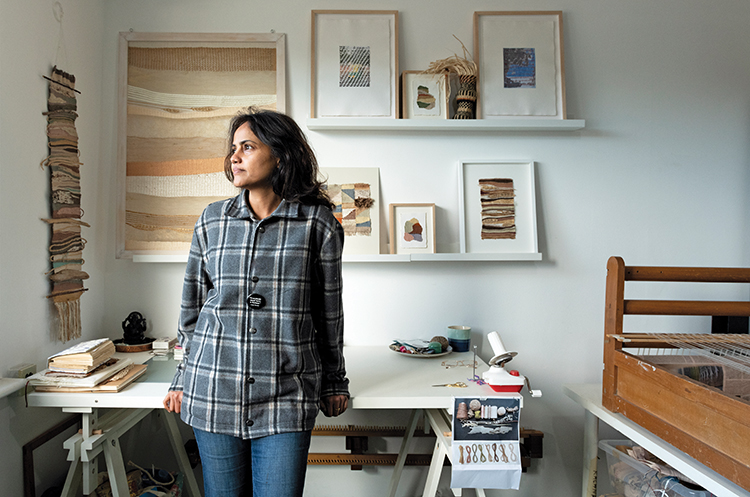
I started my art practice in India in 2000, with a small loom on the dining table in a tiny apartment in the suburbs of Mumbai. I was young, fearless and confident. At 24, I thought there was no limit to the possibilities, and I could not wait for the world to “discover” me! Well, I’m not sure about being discovered, but after design school I started freelancing and working with various architects and interior designers, weaving quite a few interesting commissioned pieces.
My personal life, however, brought quite a few pauses in my creative journey — namely, having babies and moving to multiple countries: India to London to Dubai — before finally making a second home in London in 2016. All these years of settling in different homes and raising kids were dotted with a compulsion to create. I always moved around with my first loom, which is very dear to me, and continued to weave from wherever I was living.
When the rhythmic taps of my loom, earlier so reassuring for me, made it difficult to weave around my babies, I turned to hand embroidery and attended the Royal School of Needlework in London to learn technical hand embroidery. With young children, the softness and calmness of embroidery felt natural, and I designed and embroidered quilts and cushions when weaving was not possible. Gradually, I started showing my pieces in exhibitions and shows, and slowly gained a rhythm and flow in my work.
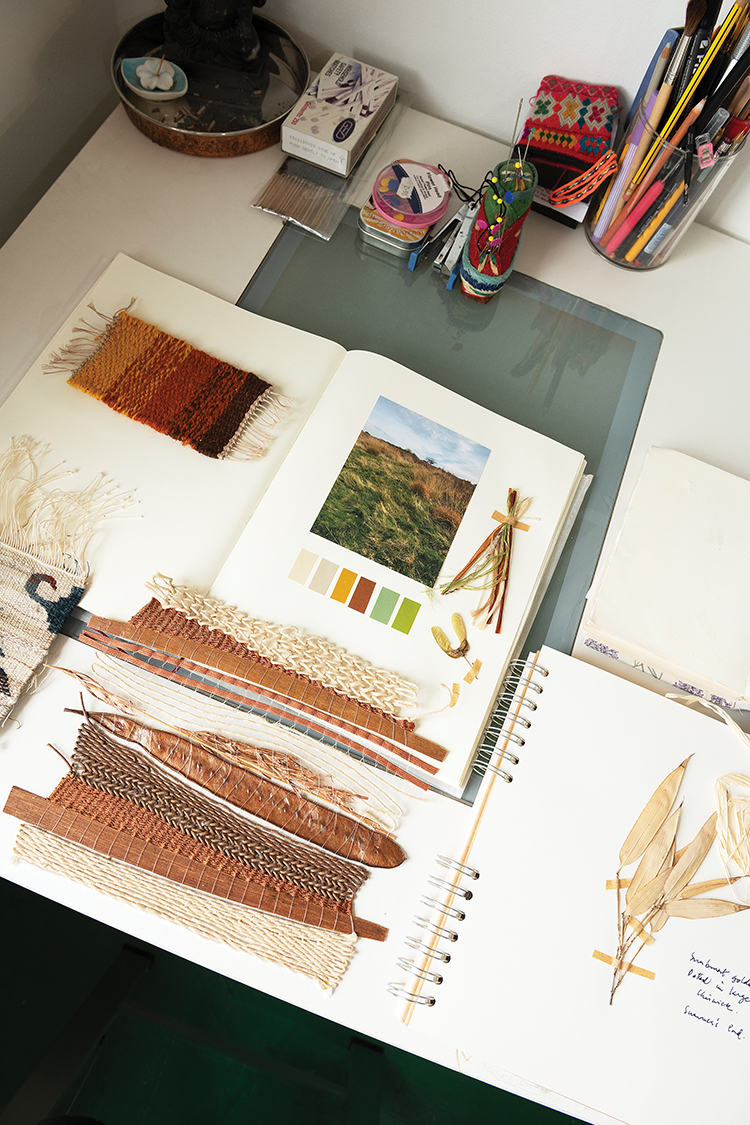
I used to dream of a dedicated private studio space, without the distraction of household chores. I felt it would focus my thoughts and ideas and help establish a discipline and rigour in my daily practice. For me, a studio away from home, to channel my creativity, has only been possible since 2017. Until that time, I wove and embroidered from home. My family got used to yarns and books spilling out of every corner, and I became skillful at hiding my “mess” away before guests arrived for lunches and dinners.
Now, at 48, I find myself feeling the same excitement and sense of possibility I felt at 24. As I get ready to send my second baby off to university and give the fascinating world of textile art a renewed, wholehearted go, this time I do so with an internal quietude that only a “lived” life can provide. In A Room of One’s Own, Virginia Woolf wrote, “There is no gate, no lock, no bolt that you can set upon the freedom of my mind.” I can only achieve this state in my own studio — and believe that a space to create is vital for an artist.
When I finally moved my practice from home to a studio in 2017, life altered immeasurably for me. In addition to getting a dedicated space to work outside of my home, I finally met my tribe of artists and makers whom I had not previously been acquainted with in London. Being an artist is a challenging career, and quite often I get discouraged, lost in self-doubt, and goals can slide. When I have a strong art community, I am able to access support and encouragement from a place of understanding and shared experience.
As I gradually got acquainted with the vibrant artists in the shared studio, I finally started to believe I was not alone in my artistic endeavour. Having daily access to a community of peers helped me to stay on track and to create my art with all of my energy and passion. A strong artistic community also provides the support I need to stay motivated and continue creating. Moreover, it has helped me to find opportunities to collaborate with other artists and showcase work to a growing audience. I was recently selected for a collaborative art residency in Wales with another visual artist from my studio and we are working together on a new collection of works to showcase later this year.
Artist studios at subsidised rates are hard to come by and, unfortunately, a lot of studio spaces get lost to real estate developers. In the last six years, I have had to move studios four times within West London. Every move causes immense heartache as I leave colleagues, but also empowers me with a new set of creative colleagues whose company and friendship have been vital to my growth as an artist.
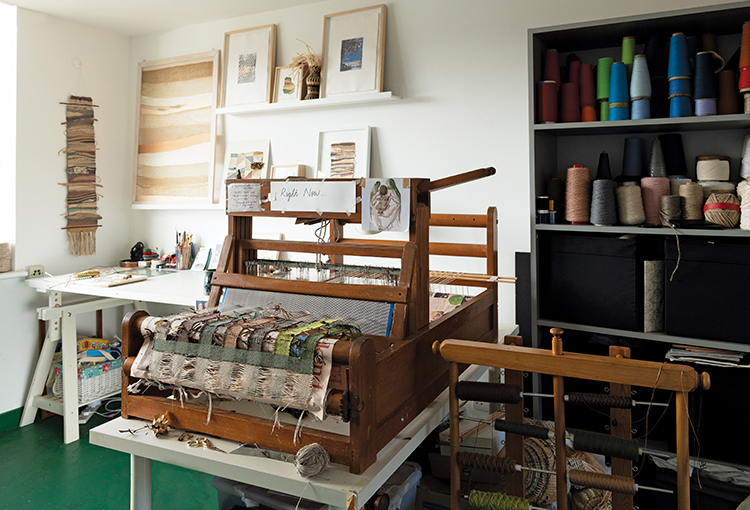
My studio is on the second floor. The balcony overlooks a few birch trees, and a charming garden, which is a little oasis. On a busy day, I will take five minutes just sitting out there to reset. On the other side, large windows overlook a beautiful and vibrant ethnic food and clothes market, which feels frozen in time, contrasting the constantly passing London Underground, filled with commuters on a loop, chasing time and dreams.
I do more than look out of the window for inspiration — long walks in nature are integral to my art practice. I’m constantly collecting and gathering natural pieces like leaves, bark and seed pods, which regularly make an appearance in my weaves. I do my best thinking when I’m out in nature in the quiet, steadfast company of trees and plants. All these years living close to the River Thames and being lucky enough to have had temporary studios around the river has also fed into my textile practice. These woodland and river walks help me distil mindfulness into spontaneous ideas.
When I say “woodland,” I do not necessarily mean you have to live at the edge of a forest or have a studio in the woods. I have always lived in cities and my woodland is, and always has been, the closest green patch I can find. I then need the quiet of my studio to bring all my thoughts and inspiration to life. This is when memories, thoughts — past and present — fuse together and new ideas are born: treating the gathered materials, journaling, making mood boards and, finally, preparing the loom for weaving. My intricately woven textures are akin to viewing a landscape, capturing the atmosphere, tone and emotion from my daily walks.
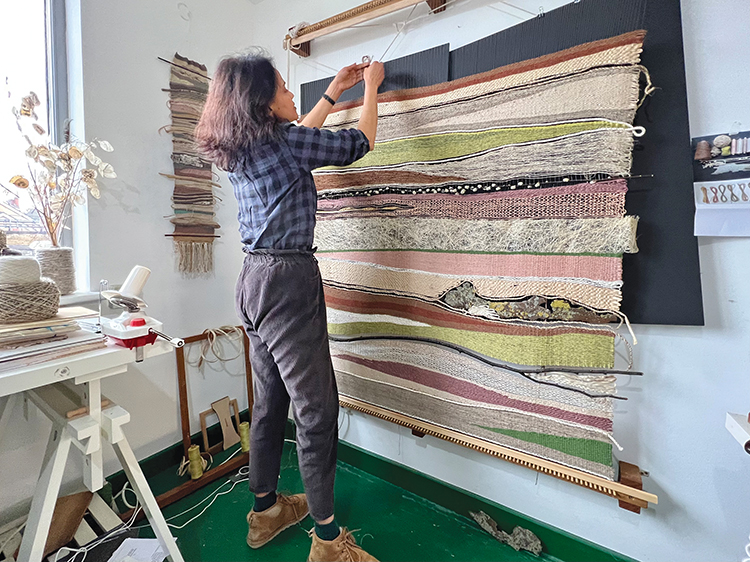
My current studio is a 25-minute walk from home. I usually hop on the bus, which reduces the commute to 10 minutes, but every few days I walk and take the longer route through a local park, spending a few minutes in the company of maple, eucalyptus, sweet chestnut and oak trees.
As the studio is not that large, I constantly refigure my shelves and table to accommodate occasional large commissions when I need to use the larger studio wall, and to weave on a clever portable device that was designed by a fellow artist in the studio for me. Thus, the studio, as the environment outside, is continually changing, however subtly.
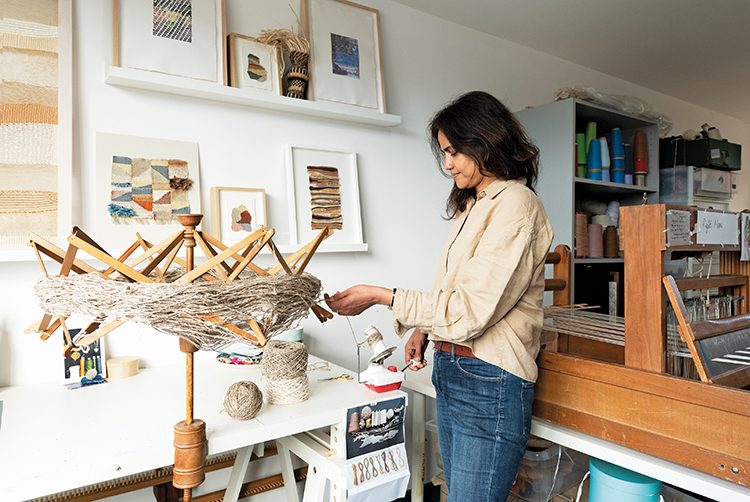
Weaving is a slow craft and, as a mother of two, I continue to spill out of the studio to corners of my home when my children are sick, on school holidays, or if I need to work late nights, early mornings or weekends to meet deadlines for shows and commissions. This constraint has actually added an interesting element to my practice. I have started weaving smaller collections on paper and on small, portable frames. I love this challenge in approach, switching between various types of looms, studio location and scale of work. It keeps my mind abuzz with possibilities and helps in approaching the craft always from a “beginner’s mind.”
All my works are unique and bespoke; each one takes shape slowly in my studio and is later crafted into screens, space dividers and framed textile art. I can’t stress enough how important the solitude in the studio is to envisioning and creating new weaves.
I would love to continue experimenting, designing and creating surfaces that help unite the “evolving self” and the “artist” within me for a more coherent voice and better artistic expression. I’m working on designing a new creative workshop for textile enthusiasts as well as developing and 83 expanding my collection of weaves to show to a wider, global audience.

I started my art practice in India in 2000, with a small loom on the dining table in a tiny apartment in the suburbs of Mumbai. I was young, fearless and confident. At 24, I thought there was no limit to the possibilities, and I could not wait for the world to “discover” me! Well, I’m not sure about being discovered, but after design school I started freelancing and working with various architects and interior designers, weaving quite a few interesting commissioned pieces.
My personal life, however, brought quite a few pauses in my creative journey — namely, having babies and moving to multiple countries: India to London to Dubai — before finally making a second home in London in 2016. All these years of settling in different homes and raising kids were dotted with a compulsion to create. I always moved around with my first loom, which is very dear to me, and continued to weave from wherever I was living.
When the rhythmic taps of my loom, earlier so reassuring for me, made it difficult to weave around my babies, I turned to hand embroidery and attended the Royal School of Needlework in London to learn technical hand embroidery. With young children, the softness and calmness of embroidery felt natural, and I designed and embroidered quilts and cushions when weaving was not possible. Gradually, I started showing my pieces in exhibitions and shows, and slowly gained a rhythm and flow in my work.

I used to dream of a dedicated private studio space, without the distraction of household chores. I felt it would focus my thoughts and ideas and help establish a discipline and rigour in my daily practice. For me, a studio away from home, to channel my creativity, has only been possible since 2017. Until that time, I wove and embroidered from home. My family got used to yarns and books spilling out of every corner, and I became skillful at hiding my “mess” away before guests arrived for lunches and dinners.
Now, at 48, I find myself feeling the same excitement and sense of possibility I felt at 24. As I get ready to send my second baby off to university and give the fascinating world of textile art a renewed, wholehearted go, this time I do so with an internal quietude that only a “lived” life can provide. In A Room of One’s Own, Virginia Woolf wrote, “There is no gate, no lock, no bolt that you can set upon the freedom of my mind.” I can only achieve this state in my own studio — and believe that a space to create is vital for an artist.
When I finally moved my practice from home to a studio in 2017, life altered immeasurably for me. In addition to getting a dedicated space to work outside of my home, I finally met my tribe of artists and makers whom I had not previously been acquainted with in London. Being an artist is a challenging career, and quite often I get discouraged, lost in self-doubt, and goals can slide. When I have a strong art community, I am able to access support and encouragement from a place of understanding and shared experience.
As I gradually got acquainted with the vibrant artists in the shared studio, I finally started to believe I was not alone in my artistic endeavour. Having daily access to a community of peers helped me to stay on track and to create my art with all of my energy and passion. A strong artistic community also provides the support I need to stay motivated and continue creating. Moreover, it has helped me to find opportunities to collaborate with other artists and showcase work to a growing audience. I was recently selected for a collaborative art residency in Wales with another visual artist from my studio and we are working together on a new collection of works to showcase later this year.
Artist studios at subsidised rates are hard to come by and, unfortunately, a lot of studio spaces get lost to real estate developers. In the last six years, I have had to move studios four times within West London. Every move causes immense heartache as I leave colleagues, but also empowers me with a new set of creative colleagues whose company and friendship have been vital to my growth as an artist.

My studio is on the second floor. The balcony overlooks a few birch trees, and a charming garden, which is a little oasis. On a busy day, I will take five minutes just sitting out there to reset. On the other side, large windows overlook a beautiful and vibrant ethnic food and clothes market, which feels frozen in time, contrasting the constantly passing London Underground, filled with commuters on a loop, chasing time and dreams.
I do more than look out of the window for inspiration — long walks in nature are integral to my art practice. I’m constantly collecting and gathering natural pieces like leaves, bark and seed pods, which regularly make an appearance in my weaves. I do my best thinking when I’m out in nature in the quiet, steadfast company of trees and plants. All these years living close to the River Thames and being lucky enough to have had temporary studios around the river has also fed into my textile practice. These woodland and river walks help me distil mindfulness into spontaneous ideas.
When I say “woodland,” I do not necessarily mean you have to live at the edge of a forest or have a studio in the woods. I have always lived in cities and my woodland is, and always has been, the closest green patch I can find. I then need the quiet of my studio to bring all my thoughts and inspiration to life. This is when memories, thoughts — past and present — fuse together and new ideas are born: treating the gathered materials, journaling, making mood boards and, finally, preparing the loom for weaving. My intricately woven textures are akin to viewing a landscape, capturing the atmosphere, tone and emotion from my daily walks.

My current studio is a 25-minute walk from home. I usually hop on the bus, which reduces the commute to 10 minutes, but every few days I walk and take the longer route through a local park, spending a few minutes in the company of maple, eucalyptus, sweet chestnut and oak trees.
As the studio is not that large, I constantly refigure my shelves and table to accommodate occasional large commissions when I need to use the larger studio wall, and to weave on a clever portable device that was designed by a fellow artist in the studio for me. Thus, the studio, as the environment outside, is continually changing, however subtly.

Weaving is a slow craft and, as a mother of two, I continue to spill out of the studio to corners of my home when my children are sick, on school holidays, or if I need to work late nights, early mornings or weekends to meet deadlines for shows and commissions. This constraint has actually added an interesting element to my practice. I have started weaving smaller collections on paper and on small, portable frames. I love this challenge in approach, switching between various types of looms, studio location and scale of work. It keeps my mind abuzz with possibilities and helps in approaching the craft always from a “beginner’s mind.”
All my works are unique and bespoke; each one takes shape slowly in my studio and is later crafted into screens, space dividers and framed textile art. I can’t stress enough how important the solitude in the studio is to envisioning and creating new weaves.
I would love to continue experimenting, designing and creating surfaces that help unite the “evolving self” and the “artist” within me for a more coherent voice and better artistic expression. I’m working on designing a new creative workshop for textile enthusiasts as well as developing and 83 expanding my collection of weaves to show to a wider, global audience.






